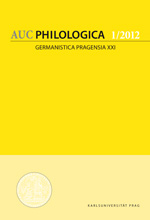Den kluvna kärnan: Läsningar av Birgitta Trotzigs ”Ormflickan”
The Split Kernel. Readings of Birgitta Trotzig’s ”Ormflickan” (”The Serpent Girl”)
Author(s): Krzysztof BakSubject(s): Language and Literature Studies
Published by: Univerzita Karlova v Praze, Nakladatelství Karolinum
Keywords: Birgitta Trotzig; fairy-tale; myth; Demeter and Persephone; New Theology; Teilhard de Chardin; Christian voluntarism
Summary/Abstract: The paper examines certain semantic aspects of Birgitta Trotzig’s ”Ormflickan” (”The Serpent Girl”), included in I kejsarens tid (In the Time of the Emperor), a collection of short stories, published in 1975. Profiting from Roland Barthes’ distinction between two approaches to a literary text – the text viewed as an apricot (the kernel representing the meaning centre and the flesh the form) and the text as an onion (a decentered construction of levels and layers) – the paper demonstrates that ”Ormflickan” has a paradoxical textual and hermeneutic structure. On the one hand the author provides the story with an apricot-like semantic kernel, effectively determining the strategic levels of the text. On the other hand the semantic organization of the story possesses such a complexity that the kernel meaning of ”Ormflickan” can be uncovered only by a series of pluralistic onion-related interpretations. The interpretations presented in this paper take as their starting point Trotzig’s own aesthetic method and focus on how the story treats two of the author’s favourite generic conventions: the fairy-tale and the myth, represented by the old Scanian fairy-tale about King Lindorm and the classical myth of Demeter and Persephone. On all structural levels of Trotzig’s story the arrangements of the intertextual and architextual material are, the paper argues, determined by the Christian anthropology, which turns out to be the semantic core of ”Ormflickan”. The story calls into play two rival Christian outlooks, the evolutionary theory of Pierre Teilhard de Chardin and the voluntaristic anthropology of Augustine and Luther, without trying to bring about their reconciliation. The hermeneutic kernel of the story is consequently marred by a semantic split, which destabilizes the meaning production in ”Ormflickan” and corresponds to the author’s own, often publicly declared, religious doubleness.
Journal: Acta Universitatis Carolinae Philologica
- Issue Year: 2012
- Issue No: 1
- Page Range: 87-118
- Page Count: 32
- Language: Swedish

